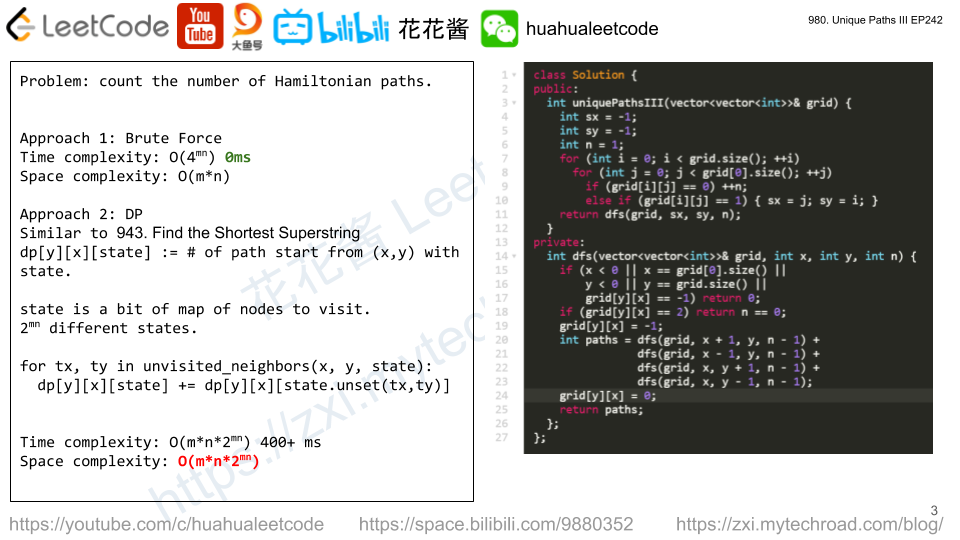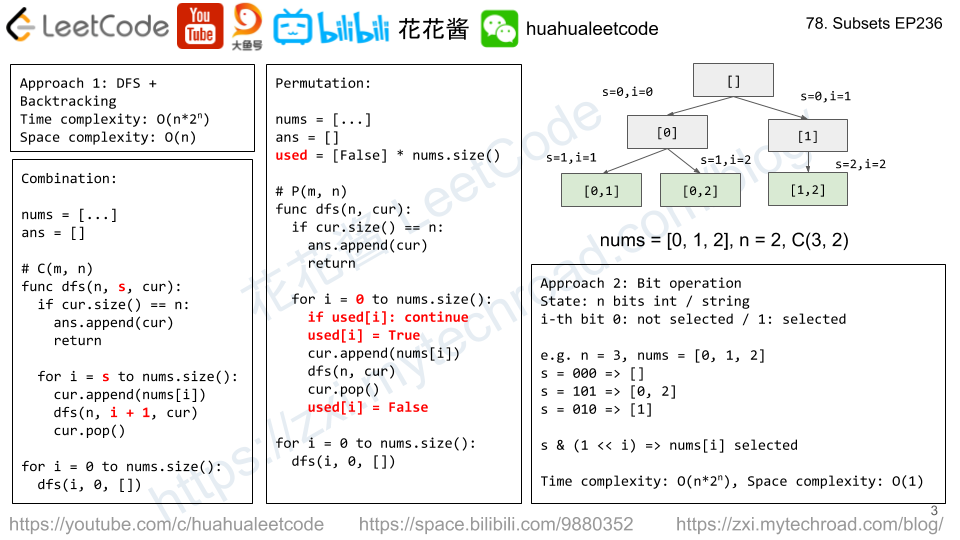Given an array A of non-negative integers, the array is squareful if for every pair of adjacent elements, their sum is a perfect square.
Return the number of permutations of A that are squareful. Two permutations A1 and A2 differ if and only if there is some index i such that A1[i] != A2[i].
Example 1:
Input: [1,17,8] Output: 2 Explanation: [1,8,17] and [17,8,1] are the valid permutations.
Example 2:
Input: [2,2,2] Output: 1
Note:
1 <= A.length <= 120 <= A[i] <= 1e9
Solution1: DFS
Try all permutations with pruning.
Time complexity: O(n!)
Space complexity: O(n)
C++
|
1 2 3 4 5 6 7 8 9 10 11 12 13 14 15 16 17 18 19 20 21 22 23 24 25 26 27 28 29 30 31 32 33 34 35 36 37 |
// Author: Huahua, running time: 4 ms, 8.8 MB class Solution { public: int numSquarefulPerms(vector<int>& A) { std::sort(begin(A), end(A)); vector<int> cur; vector<int> used(A.size()); int ans = 0; dfs(A, cur, used, ans); return ans; } private: bool squareful(int x, int y) { int s = sqrt(x + y); return s * s == x + y; } void dfs(const vector<int>& A, vector<int>& cur, vector<int>& used, int& ans) { if (cur.size() == A.size()) { ++ans; return; } for (int i = 0; i < A.size(); ++i) { if (used[i]) continue; // Avoid duplications. if (i > 0 && !used[i - 1] && A[i] == A[i - 1]) continue; // Prune invalid solutions. if (!cur.empty() && !squareful(cur.back(), A[i])) continue; cur.push_back(A[i]); used[i] = 1; dfs(A, cur, used, ans); used[i] = 0; cur.pop_back(); } } }; |
Solution 2: DP Hamiltonian Path
dp[s][i] := # of ways to reach state s (binary mask of nodes visited) that ends with node i
dp[s | (1 << j)][j] += dp[s][i] if g[i][j]
Time complexity: O(n^2*2^n)
Space complexity: O(2^n)
C++
|
1 2 3 4 5 6 7 8 9 10 11 12 13 14 15 16 17 18 19 20 21 22 23 24 25 26 27 28 29 30 31 32 33 34 35 36 37 38 39 40 41 42 43 44 |
// Author: Huahua, running time: 20 ms, 14.9 MB class Solution { public: int numSquarefulPerms(vector<int>& A) { const int n = A.size(); // For deduplication. std::sort(begin(A), end(A)); // g[i][j] == 1 if A[i], A[j] are squareful. vector<vector<int>> g(n, vector<int>(n)); // dp[s][i] := number of ways to reach state s and ends with node i. vector<vector<int>> dp(1 << n, vector<int>(n)); for (int i = 0; i < n; ++i) { for (int j = 0; j < n; ++j) { if (i == j) continue; int r = sqrt(A[i] + A[j]); if (r * r == A[i] + A[j]) g[i][j] = 1; } } // For the same numbers, only the first one can be the starting point. for (int i = 0; i < n; ++i) if (i == 0 || A[i] != A[i - 1]) dp[(1 << i)][i] = 1; int ans = 0; for (int s = 0; s < (1 << n); ++s) for (int i = 0; i < n; ++i) { if (!dp[s][i]) continue; for (int j = 0; j < n; ++j) { if (!g[i][j]) continue; if (s & (1 << j)) continue; // Only the first one can be used as the dest. if (j > 0 && !(s & (1 << (j - 1))) && A[j - 1] == A[j]) continue; dp[s | (1 << j)][j] += dp[s][i]; } } for (int i = 0; i < n; ++i) ans += dp[(1 << n) - 1][i]; return ans; } }; |


